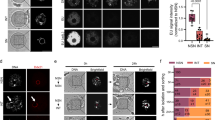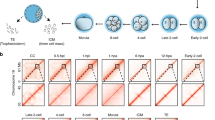Abstract
Nuclear transplantation experiments in amphibia and mammals have shown that oocyte and egg cytoplasm can extensively reprogram somatic cell nuclei with new patterns of gene expression and new pathways of cell differentiation1,2,3; however, very little is known about the molecular mechanism of nuclear reprogramming. Here we have used nuclear and DNA transfer from mammalian somatic cells to analyse the mechanism of activation of the stem cell marker gene oct4 by Xenopus oocytes. We find that the removal of nuclear protein accelerates the rate of reprogramming, but even more important is the demethylation of somatic cell DNA. DNA demethylation seems to precede gene reprogramming, and is absolutely necessary for oct4 transcription. Reprogramming by oocytes occurs in the absence of DNA replication and RNA/protein synthesis. It is also selective, operating only on the promoter, but not enhancers, of oct4; both a putative Sp1/Sp3 and a GGGAGGG binding site are required for demethylation and transcription. We conclude that the demethylation of promoter DNA may be a necessary step in the epigenetic reprogramming of somatic cell nuclei.
This is a preview of subscription content, access via your institution
Access options
Subscribe to this journal
Receive 12 print issues and online access
$209.00 per year
only $17.42 per issue
Buy this article
- Purchase on Springer Link
- Instant access to full article PDF
Prices may be subject to local taxes which are calculated during checkout




Similar content being viewed by others
References
Gurdon, J.B. The developmental capacity of nuclei taken from intestinal epithelium cells of feeding tadpoles. J. Embryol. Exp. Morphol. 10, 622–640 (1962).
Wilmut, I. et al. Somatic cell nuclear transfer. Nature 419, 583–586 (2002).
Gurdon, J.B., Byrne, J.A. & Simonsson, S. Nuclear reprogramming and stem cell creation. Proc. Natl Acad. Sci. USA 100, 11819–11822 (2003).
De Robertis, E.M. & Gurdon, J.B. Gene activation in somatic nuclei after injection into amphibian oocytes. Proc. Natl Acad. Sci. USA 74, 2470–2474 (1977).
Byrne, J.A., Simonsson, S., Western, P.S. & Gurdon, J.B. Nuclei of adult mammalian somatic cells are directly reprogrammed to oct-4 stem cell gene expression by amphibian oocytes. Curr. Biol. 13, 1206–1213 (2003).
Surani, M.A. Reprogramming of genome function through epigenetic inheritance. Nature 414, 122–128 (2001).
Stancheva, I., El-Maarri, O., Walter, J., Niveleau, A. & Meehan, R.R. DNA methylation at promoter regions regulates the timing of gene activation in Xenopus laevis embryos. Dev. Biol. 243, 155–165 (2002).
Boiani, M., Eckardt, S., Scholer, H.R. & McLaughlin, K.J. Oct4 distribution and level in mouse clones: consequences for pluripotency. Genes Dev. 16, 1209–1219 (2002).
Bortvin, A. et al. Incomplete reactivation of Oct4-related genes in mouse embryos cloned from somatic nuclei. Development 130, 1673–1680 (2003).
Dean, W., Santos, F. & Reik, W. Epigenetic reprogramming in early mammalian development and following somatic nuclear transfer. Semin. Cell Dev. Biol. 14, 93–100 (2003).
Matsuo, K. et al. An embryonic demethylation mechanism involving binding of transcription factors to replicating DNA. EMBO J. 17, 1446–1453 (1998).
Kimura, H., Suetake, I. & Tajima, S. Xenopus maintenance-type DNA methyltransferase is accumulated and translocated into germinal vesicles of oocytes. J. Biochem. (Tokyo) 125, 1175–1182 (1999).
Curradi, M., Izzo, A., Badaracco, G. & Landsberger, N. Molecular mechanisms of gene silencing mediated by DNA methylation. Mol. Cell. Biol. 22, 3157–3173 (2002).
Pesce, M. & Scholer, H.R. Oct-4: gatekeeper in the beginnings of mammalian development. Stem Cells 19, 271–278 (2001).
Niwa, H., Miyazaki, J. & Smith, A.G. Quantitative expression of Oct-3/4 defines differentiation, dedifferentiation or self-renewal of ES cells. Nature Genet. 24, 372–376 (2000).
Nordhoff, V. et al. Comparative analysis of human, bovine, and murine Oct-4 upstream promoter sequences. Mamm. Genome 12, 309–317 (2001).
Gidekel, S. & Bergman, Y. A unique developmental pattern of Oct-3/4 DNA methylation is controlled by a cis-demodification element. J. Biol. Chem. 277, 34521–34530 (2002).
Gurdon, J.B. & Melton, D.A. Gene transfer in amphibian eggs and oocytes. Annu. Rev. Genet. 15, 189–218 (1981).
Belikov, S., Gelius, B., Almouzni, G. & Wrange, O. Hormone activation induces nucleosome positioning in vivo. EMBO J. 19, 1023–1033 (2000).
Modak, S.P., Principaud, E. & Spohr, G. Regulation of Xenopus c-myc promoter activity in oocytes and embryos. Oncogene 8, 645–654 (1993).
Luckow, B. & Schutz, G. CAT constructions with multiple unique restriction sites for the functional analysis of eukaryotic promoters and regulatory elements. Nucleic Acids Res. 15, 5490 (1987).
Mohun, T.J., Garrett, N. & Gurdon, J.B. Upstream sequences required for tissue-specific activation of the cardiac actin gene in Xenopus laevis embryos. EMBO J. 5, 3185–3193 (1986).
Steinbeisser, H., Hofmann, A., Stutz, F. & Trendelenburg, M.F. Different regulatory elements are required for cell-type and stage specific expression of the Xenopus laevis skeletal muscle actin gene upon injection in X. laevis oocytes and embryos. Nucleic Acids Res. 16, 3223–3238 (1988).
Siegfried, Z. et al. DNA methylation represses transcription in vivo. Nature Genet. 22, 203–206 (1999).
Hattori, N. et al. Epigenetic control of mouse Oct-4 gene expression in ES cells and TS cells. J. Biol. Chem. 279, 17063–17069 (2004).
Hinkley, C.S., Martin, J.F., Leibham, D. & Perry, M. Sequential expression of multiple POU proteins during amphibian early development. Mol. Cell. Biol. 12, 638–649 (1992).
Kikyo, N., Wade, P.A., Guschin, D., Ge, H. & Wolffe, A.P. Active remodeling of somatic nuclei in egg cytoplasm by the nucleosomal ATPase ISWI. Science 289, 2360–2362 (2000).
Wade, P.A. & Kikyo, N. Chromatin remodeling in nuclear cloning. Eur. J. Biochem. 269, 2284–2287 (2002).
Gurdon, J.B. Nuclear transplantation in eggs and oocytes. J. Cell Sci. Suppl. 4, 287–318 (1986).
Gonda, K. et al. Reversible disassembly of somatic nucleoli by the germ cell proteins FRGY2a and FRGY2b. Nature Cell Biol. 5, 205–210 (2003).
Acknowledgements
We thank T.J. Mohun, G. Spohr and A. Smith for gifts of DNA constructs; N. Garrett for help, especially with the construction of DNA mutations; C. Lee for a supply of mouse thymocytes; and P. Hurd, A. Bannister, P. Hajkova and J. Byrne for discussion. Our work is supported by the Biotechnology and Biological Sciences Research Council, the Swedish Foundation for International Cooperation in Research and Higher Education, the Wellcome Trust and the European Commission.
Author information
Authors and Affiliations
Corresponding author
Ethics declarations
Competing interests
The authors declare no competing financial interests.
Rights and permissions
About this article
Cite this article
Simonsson, S., Gurdon, J. DNA demethylation is necessary for the epigenetic reprogramming of somatic cell nuclei. Nat Cell Biol 6, 984–990 (2004). https://doi.org/10.1038/ncb1176
Received:
Accepted:
Published:
Issue Date:
DOI: https://doi.org/10.1038/ncb1176
This article is cited by
-
Genome-wide analysis of cell-Free DNA methylation profiling with MeDIP-seq identified potential biomarkers for colorectal cancer
World Journal of Surgical Oncology (2022)
-
Global DNA methylation profiles of buffalo (Bubalus bubalis) preimplantation embryos produced by handmade cloning and in vitro fertilization
Scientific Reports (2022)
-
Epigenetic reprogramming of cell identity: lessons from development for regenerative medicine
Clinical Epigenetics (2021)
-
Nanosecond pulsed electric fields enhance mesenchymal stem cells differentiation via DNMT1-regulated OCT4/NANOG gene expression
Stem Cell Research & Therapy (2020)
-
Hypoxia-induced cancer stemness acquisition is associated with CXCR4 activation by its aberrant promoter demethylation
BMC Cancer (2019)



